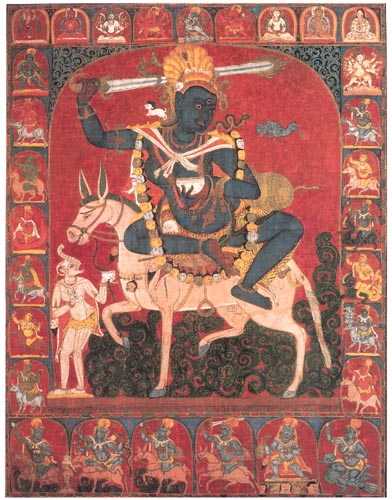| 31. Palden Lhamo
|

31.
PaIden Lhamo
Central Tibet, 14th century
Distemper on cloth
73.7 x 58.4 cm (29 x 23 in.)
Pritzker Collection
|
Palden Lhamo (Glorious Goddess) is a Tibetan form of the ancient Indian goddess Shridevi. Like her Indian
precursor, Palden Lhamo rides a mule whose haunch is marked with an eye, an iconographic element associated with an early myth surrounding Shridevi. Once, while queen of Sri Lanka, Shridevi strenuously objected to her husband's practice of human sacrifice and threatened to kill their son if her husband's barbarism did not cease. When human sacrifice continued, she carried out her promise. As the goddess mounted a mule (covered with the flayed skin of her son) to flee the kingdom, the king aimed an arrow in her direction, hitting the mule's haunch.
Shridevi removed the arrow and magically transformed the wound into an eye, thus augmenting her powers to see and watch over the realms of the Buddhist faith.
Giuseppe Tucci and René de Nebesky-Wojkowitz have explored the development of Palden Lhamo in Tibet,
demonstrating that while she served as a protector of the Buddhist faith (dharmapala) - the only female deity to do so - she was also associated with ancient pre-Buddhist deities, including those connected with the creation and suppression of
disease.1 Her cult is said to have been
introduced to Tibet by Urgyen Sangwa Sherab (act. 10th century?), perhaps the historical figure on the left in the
top register. Although little is known about her early veneration, when worshiped by the Sakya and then the
Gelukpa order, especially from the sixteenth century onward, this goddess became associated with the protection of Lhasa and of the Dalai Lama.2
While she often appears in early Tibetan paintings as a subsidiary protector goddess (see cat. nos. 14, 17,
30), she is rarely depicted as the main subject in early paintings. This is the earliest such example published to
date. Very little of the early liturgy is associated with Palden Lhamo, and one can offer only the most tentative
identification of her entourage, based on later textual sources that only imperfectly match the
iconography presented here. In this
painting, the goddess holds a skull cup and a flaming sword, its hilt made of a scorpion.3 From her right earring a lion emerges; from the left, a snake. She cradles, under her left arm, a sack made from the skin of a mongoose, spilling jewels, but also described in the literature as containing diseases. A crescent moon appears in her headdress, and
a solar disk adorns her navel. She rides on a sea of blood, indicated here by the dark red platform supporting her
mount, below which swelling liquid is carefully delineated. Dark scrolls appear beneath and behind her mount, who is confronted by a makara-headed goddess
(makarakuti), wearing a cape of flayed human skin, the left half of whose body is emaciated. In the two side registers are
twelve attendant goddesses, none of whom corresponds precisely with known iconographic descriptions of Shridevi's retinue; they are probably the twelve
Tansrung, whom Tucci describes as "ancient native deities of Tibet."4 Their wrathful appearance resembles that of the main
goddess, and all ride fantastical animal mounts, including a dragon, a camel, a makara, and a
nine-headed beast. In the bottom register are six further attendants: four goddesses riding mules, a standing deity wearing a flayed human skin, and another borne by a large bird. The full significance of this raw, powerful work will remain uncertain until future research more precisely determines the time and place of its execution and the full intent behind its wildly imaginative iconography.
JCS
1. Tucci 1949, vol. 2,
pp. 590-94;
Tucci, Tsaparang, 1989, pp. 96-103; and Nebesky-Wojkowitz 1975. [back]
2. Tucci 1949, VOL 2, pp. 590-91; New York, Wisdom, 1991,
p. 301. [back]
3. Heller, "Notes," 1997. [back]
4. Tucci 1949, vol. 2, p. 591. [back]
|
